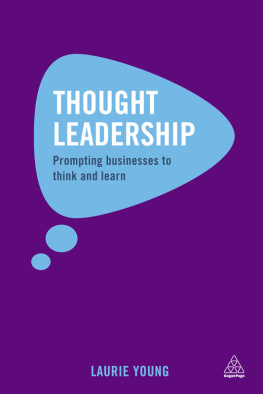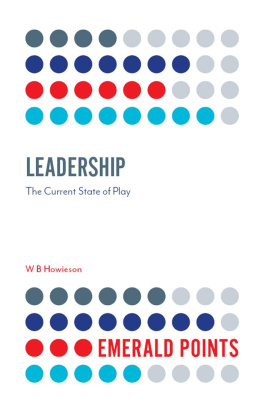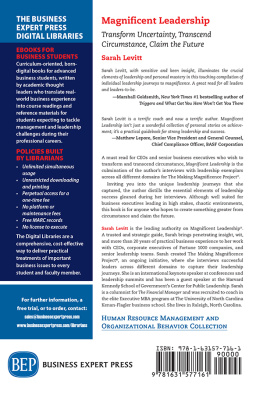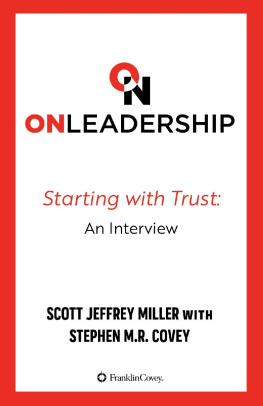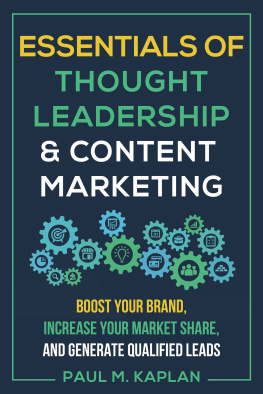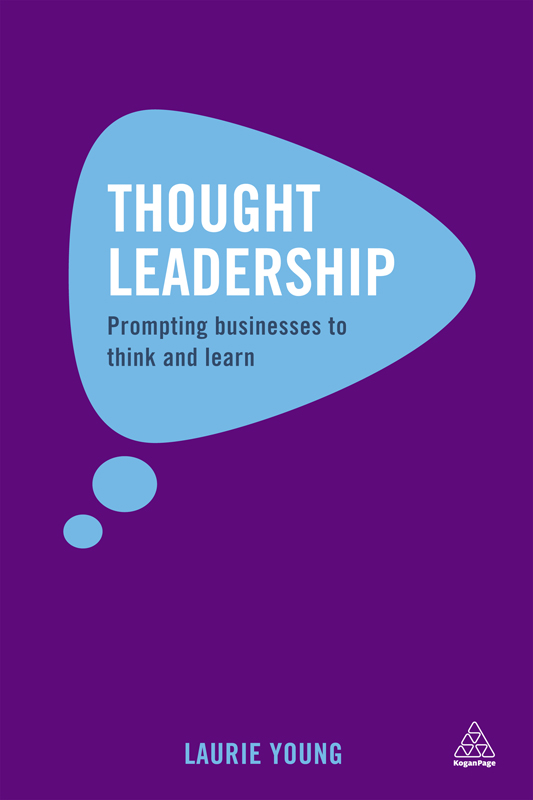Note on the Ebook Edition For an optimal reading experience, please view largetables and figures in landscape mode. |
This ebook published in 2013 by
Kogan Page Limited
120 Pentonville Road
London N1 9JN
UK
www.koganpage.com
Laurie Young, 2013
E-ISBN 9780749465124
CONTENTS
P eople usually start a book with a Preface or an Introduction, full of thanks to those who have helped out and explaining where the idea came from. The trouble is that nobody really reads them. At the same time, it seems, modern, time-constrained business people want to have a summary of what a business book is all about, in order to judge whether it is worth dipping into. So, in the service of practicality, I am going to abuse the generosity of the people who have helped me one more time and ignore convention.
There are certainly many people that I should thank. Busy senior executives and professionals in famous businesses across the world have given their time to shape my thoughts. Academic friends have helped me with research, librarians have shown enormous patience with a ham-fisted amateur and several first-rate businesses have agreed to go on the record as case studies.
This oeuvre is not about them though. It is a simple essay that tries to capture the essence of those efforts and why they all supported the aims of the book. It is designed for those people who have very little time and have, perhaps, had the book shoved into their hands by a colleague who said: Here read this; its got some good stuff on Thought Leadership. As you flip open this page by your desk, near the water cooler or in the airport bookshop, heres what I wanted to say:
What its about
Thought Leadership is a term that has emerged in Western businesses over the past 30 years. If you have never heard of it before or you are inclined to dismiss it as a jargon-sounding fad, then think again. This is not advertising, knowledge management or innovation. Neither is it just marketing. It is a unique business tool with distinct characteristics and success factors. In essence it is the creation of ideas to help businesses succeed; and it is done deliberately.
Serious people who represent some of the worlds most respected businesses use this to great effect. They include: McKinsey, Bain, Deloitte, IBM, Ernst & Young, Philips, PricewaterhouseCoopers and Fujitsu. Senior people set aside large funds and recruit skilled specialists to use this fast-developing business tool. No one would go on the record about the actual budgets they dedicate to it but sums in excess of US $100 million have been clocked up in some places. As a result, the cumulative impact on the business world of this effort is astounding.
As intriguing is the fact that Thought Leadership has been used, just as successfully, by individuals and small organizations. Some have become fabulously wealthy by using it and others have founded influential and enduring organizations through it. Both Ogilvy & Mather and the Boston Consulting Group owe their reputation, in part, to this technique. People such as Michael Hammer and Tom Peters have had impact on thousands of businesses through it.
Thought Leadership is the creation and dissemination of ideas that have direct relevance to business. It is responsible for some of the routine, boring processes of business life: management by objectives, cost management for competitive advantage and the structure of the balance sheet. It also encompasses famous, more modern concepts such as: TQM, process re-engineering, customer loyalty and cloud computing. It is found in thousands of reports, in successive waves of business books and on websites across the Western world. It is prevalent in the professions and in technology industries but also occurs in consumer markets. IBMs Innovation that matters and Unilevers Natural beauty programmes were Thought Leadership projects with similar ambitions, influence and success with their respective audiences. The passionate advocates of Fairtrade have even realigned a large part of international trade through it.
More than that, it seems that Thought Leadership has been used by business people for three-hundred years; even though they did not call it that in the past. The British originators of the industrial revolution, the charismatic founder of Unilever and the original owners of Coca-Cola (to name but a few) have used interesting ideas to start brands and to create opportunities. So, it has a remarkable track record of success and wealth creation.
Why its important
It seems that this tool is getting more and more important. Changing standards among educated populations are having a dramatic effect on businesses large and small. Modern buyers simply will not let organizations get away with behaviours or practices that affront their values. Profit and success depend on reputation and reputation depends on alignment with modern attitudes. Many different businesses are therefore using Thought Leadership to communicate their commitment to, say, green or sustainable policies.
Secondly, as I write, the professional environment in the West is changing as a new generation of business people reach maturity in their careers. Digital natives, who have grown up with the web and with social media, are reaching positions of authority. To them, the internet is a natural part of life and not new technology; it is as familiar as television is to their parents. Numerous reports and research studies show that they are behaving differently from past generations of business people. They will graze and consume information on the web, using that as a basis to select suppliers, and they are attracted to those with interesting and distinct opinions. In other words, Thought Leadership is influencing buyer behaviour more and more.
As a result of these changes, the best are getting better organized and more proficient in the creation and dissemination of Thought Leadership. They are creating explicit Thought Leadership strategies and designing ever more sophisticated programmes. In short, organizational competence in Thought Leadership is increasing.
The evidence
Shockingly, there is very little written about this powerful business tool. On the one hand it is a routine and respected method, discussed widely within leading firms. On the other, there is a disturbing silence on it in the published world. There are very few well-worked publications on it and there are hardly any academics who study it. Although many believe it to be an important component of modern marketing, it is not mentioned in one marketing book or strategy text. It is also hard to find in any business studies course or executive training programme.
Almost any other business subject is examined, researched and extensively debated. There is, though, a resounding silence on Thought Leadership and this has surprised every person with whom I have discussed it. So, to fill the vacuum, this book is based on several types of evidence. I want to set that out clearly so that you can judge its credibility for yourself.
Apart from personal experience, the sources used to compile this book include:
- Several thorough academic searches. My first searches for studies or reports on Thought Leadership revealed very little at all. So, I later asked two friends in academia (both professors) to research the subject. They confirmed that there is little published on it compared to other business topics. They could find virtually nothing at all in peer-reviewed journals.

